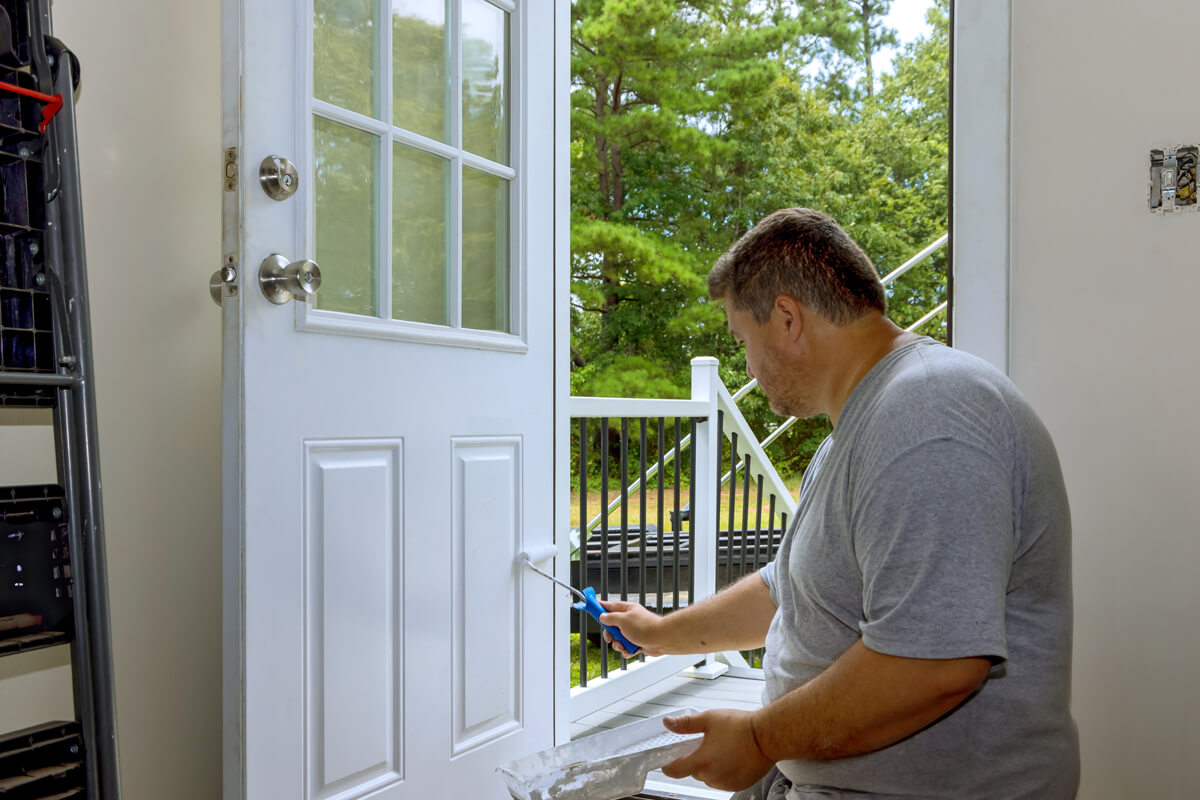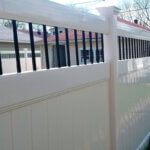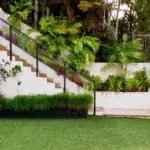Paint an exterior door correctly to boost curb appeal and protect your home’s entrance. Choose semi-gloss finish with quality exterior paint, prep the surface thoroughly by cleaning and sanding, then apply two coats following proper technique. This simple door refinishing update can add thousands to your home’s value while creating a welcoming entrance.
What Paint and Finish Should You Use?
Semi-gloss is the way to go for most front doors because it disguises any imperfections and is easy to clean. The lustrous coating resists dirt buildup and withstands frequent use better than flat or satin finishes.
For door materials, latex paint works best on wood and fiberglass doors due to its flexibility and weather resistance. Oil-based exterior paint like Rust-Oleum Protective Enamel works better for cedar, cypress, or other woods that bleed tannins. Metal doors benefit from oil-based paints that resist rust formation. Consumer Reports testing shows Behr Marquee Exterior and Benjamin Moore Aura perform exceptionally well in weathering tests. Both brands resist cracking, fading, and mildew for years of protection. The surface coating application becomes critical for this architectural element that faces constant environmental exposure.
How to Properly Prep Your Door
Surface preparation determines paint adhesion and longevity. Start with thorough cleaning using a degreasing cleaner, then rinse and let it dry.
Remove door hardware including handles, locks, and hinges when possible to prevent paint buildup and ensure clean lines. Hardware removal allows for complete door panel access during the painting process. Gently scrape away peeling paint with a putty knife, then sand with 120-grit sandpaper followed by 220-grit for a finer finish. Primer application becomes crucial for bare wood or when switching paint types. Use a high-quality stain-blocking primer on wood doors to prevent bleed-through issues that cause yellowing over time. This preparatory work ensures proper paint adhesion to the door substrate.
Step-by-Step Painting Order and Technique
Paint application follows a specific sequence for professional results: start with recessed or detailed areas using an angled brush, working from center outward to avoid drips.
Follow this painting order: raised panels first, then horizontal rails, vertical stiles, and finally door edges. Use brushes for recessed and detailed areas that require more precise application, such as edges and curves. Apply pigmented coating in thin, even coats rather than one thick layer. Keep in mind that exterior door paint dries faster in higher temperatures, lower humidity, and when exposed to direct sunlight. Brush technique matters for this home improvement project – use smooth, consistent strokes and avoid overworking the paint once applied. The application method directly impacts the final painted surface quality.
Curing, Maintenance & Common Issues
Drying time differs from cure time. While paint feels dry in hours, it will not be fully cured yet, so be careful not to scratch the surface for 24-48 hours depending on humidity and temperature.
Troubleshooting Common Problems
Latex blocking occurs when paint surfaces stick together, especially around door jambs. Prevent this by waiting full cure time before closing doors normally. Mildew growth appears as black spots, particularly in humid climates – use mildew-resistant paint formulas and ensure proper ventilation. Paint peeling usually results from poor surface prep or moisture infiltration – sand affected areas and spot-prime before repainting. These coating failures compromise the protective barrier function.
Maintenance Schedule for Longevity
Inspect painted doors annually for chips, cracks, or fading and touch up minor issues immediately to prevent moisture damage. Most quality exterior door paint lasts 8-12 years with proper maintenance, though high-traffic entries may need refreshing every 6-8 years. Regular door maintenance preserves both aesthetic appeal and weather protection.
Choosing Colors for Curb Appeal in 2025
2025 trends favor rich, deep blues, fiery reds like crimson and scarlet, and earthy greens that create personality without overwhelming your home’s architecture.
Popular hues include deep emerald greens, teal with vintage appeal, and earth tones that complement natural landscapes. Warm neutrals like sage green and terracotta provide sophisticated alternatives to stark whites. These shades pair beautifully with natural textures like stone facades, warm wood accents, and aged metals. Consider your home’s architectural style – traditional homes suit classic navy or forest green, while modern designs can handle bold yellows or dramatic blacks. The color selection should complement the building facade while expressing personal taste through this decorative element.
Paint Brands and Product Recommendations
Benjamin Moore Aura and Sherwin Williams Duration are the top options when it comes to exterior door paint. Both offer exceptional color retention and durability.
Behr Marquee Exterior at $51 per gallon provides excellent value with one-coat coverage claims, while premium options like Benjamin Moore Aura justify higher costs with superior performance. Aura’s Color Lock technology delivers what it promises – your door will keep looking fresh even after years of sun exposure. For metal doors, Benjamin Moore’s Ultra Spec in low lustre finish provides rust inhibition and control. These paint formulations represent the antithesis of cheap interior paint – they’re specifically engineered for exterior applications.
Tools and Application Tips
Essential tools include high-quality angled brushes, synthetic brushes for latex paint, foam rollers for smooth surfaces, and drop cloths for protection. The optimal temperature to paint your front door is between 65 and 70 degrees F.
Spring and autumn can be the perfect time for repainting doors thanks to warm but not overly hot weather, and lower chances of disruptive rainstorms. Professional techniques include maintaining consistent brush pressure, avoiding painting in direct sunlight, and planning around weather forecasts. Use only high quality, lint-free roller covers to avoid shedding loose fibers into your paint finish. Two thin coats always outperform one thick application – they dry more evenly and create stronger adhesion to the door surface.
Bottom Line: Paint an exterior door successfully by choosing quality semi-gloss exterior paint appropriate for your door material, preparing the surface thoroughly, and applying two thin coats using proper technique. With trending colors like deep blues, rich reds, and earthy greens dominating 2025, you can boost both curb appeal and home value with this weekend DIY project.
Key Points for Success:
- Use semi-gloss finish for durability and easy maintenance
- Prep surfaces thoroughly – cleaning and light sanding prevent future problems
- Apply primer when needed, especially on bare wood or when changing paint types
- Follow proper painting sequence: panels, rails, stiles, then edges
- Allow full cure time (24-48 hours) before normal door operation





